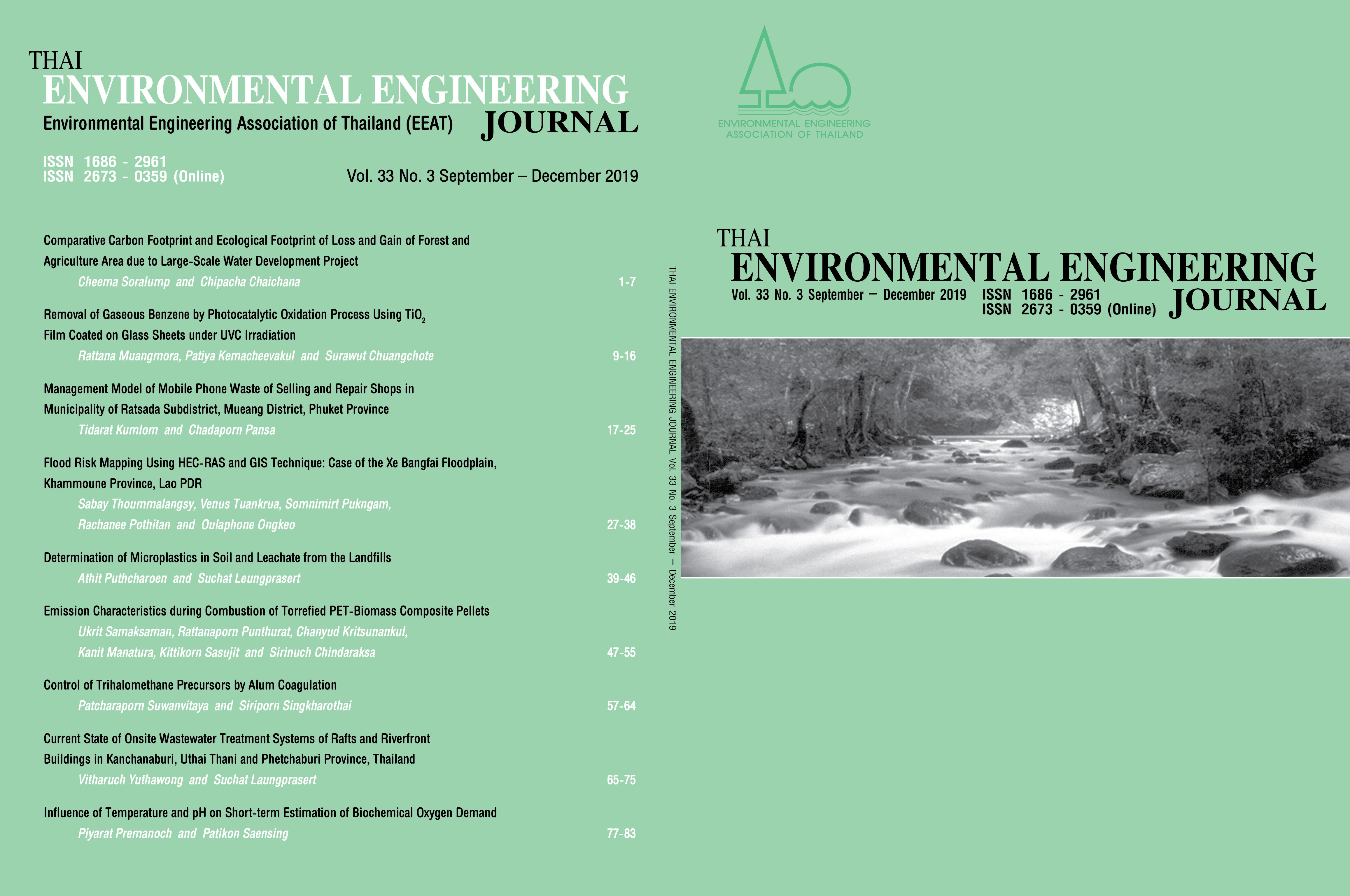Removal of Gaseous Benzene by Photocatalytic Oxidation Process Using TiO2 Film Coated on Glass Sheets under UVC Irradiation
Main Article Content
Abstract
Benzene is well known as a toxic and carcinogenic air pollutant, which is mainly emitted from industrial processes, vehicles, and residential activities. TiO2-based photocatalysis is becoming one of the most promising solutions for the treatment of benzene in the ambient air. The present study aims to investigate the photocatalytic activity of TiO2 film coated on glass sheets for the degradation of gaseous benzene under ultraviolet C (UVC) irradiation. TiO2 thin film coated glass sheets were prepared through polyvinylpyrrolidone (PVP)-modified sol-gel method coupled with the doctor blade coating technique. It was found that the obtained TiO2 film consisted of well-shaped TiO2 particles with good adherents on a glass surface. There was no crack formation found in the film. The average film thickness was 1.187 µm. The maximum removal efficiency of benzene in the photocatalysis test was 4.5 and 6.4 times higher than that of the adsorption and direct photolytic tests, respectively, within 12 h. Moreover, the higher numbers of TiO2 coated sheets, the higher photocatalytic benzene degradation, was obtained.
Article Details
References
[2] Du, J. J., Chen, W., Zhang, C., Liu, Y., Zhao, C.X. and Dai, Y. 2011. Hydrothermal synthesis of porous TiO2 microspheres and their photocatalytic degradation of gaseous benzene. Chemical Engineering Journal. 170(1): 53-58.
[3] Wallace, L.A. 1989. Major sources of benzene exposure. Environmental Health Perspectives. 82: 165- 169.
[4] Tejasvi, R., Sharma, M. and Upadhyay, K. 2015. Passive photo-catalytic destruction of air-borne VOCs in high traffic areas using TiO2-coated flexible PVC sheet. Chemical Engineering Journal. 262: 875-881.
[5] Bingham, E., Cohrssen, B. and Powell, C.H. 2001. Patty's toxicology. Volume 2: toxicological issues related to metals, neurotoxicology and radiation metals and metal compounds. John Wiley & Sons Inc., New York.
[6] Harrison, R., Saborit, J.M.D., Dor, F. and Henderson, R. Benzene. In: WHO guidelines for indoor air quality: selected pollutants, World Health Organization, 2010; 15-39.
[7] Shayegan, Z., Lee, C.S. and Haghighat, F. 2018. TiO2 photocatalyst for removal of volatile organic compounds in gas phase - A review. Chemical Engineering Journal. 334: 2408-2439.
[8] Yadav, H.M. and Kim, J.S. 2016. Solvothermal synthesis of anatase TiO2-graphene oxide nanocomposites and their photocatalytic performance. Journal of Alloys and Compounds. 688: 123-129.
[9] Binas, V., Stefanopoulos, V., Kiriakidis, G. and Papagiannakopoulos, P. 2019. Photocatalytic oxidation of gaseous benzene, toluene and xylene under UV and visible irradiation over Mn-doped TiO2 nanoparticles. Journal of Materiomics. 5(1): 56-65.
[10] He, F., Li, J.L., Li, T. and Li, G.X. 2014. Solvothermal synthesis of mesoporous TiO2: The effect of morphology, size and calcination progress on photocatalytic activity in the degradation of gaseous benzene. Chemical Engineering Journal. 237: 312-321.
[11] Ku, Y., Chen, J.S. and Chen, H.W. 2007. Decomposition of benzene and toluene in air streams in fixed-film photoreactors coated with TiO2 catalyst. Journal of the Air & Waste Management Association.57(3): 279-285.
[12] Xie, H., Liu, B.S. and Zhao, X.J. 2016. Facile process to greatly improve the photocatalytic activity of the TiO2 thin film on window glass for the photodegradation of acetone and benzene. Chemical Engineering Journal. 284: 1156-1164.
[13] Sirirerkratana, K., Kemacheevakul, P., Chuangchote, S. 2019. Color removal from wastewater by photocatalytic process using titanium dioxide-coated glass, ceramic tile, and stainless steel sheets. Journal of Cleaner Production. 215: 123-130.
[14] Karazi, S., Ahad, I., Benyounis, K. 2017. Laser Micromachining for Transparent Materials. Elsevier Inc., Ireland.
[15] Chang, H. and Seo, M. 2014. Photocatalytic Degradation of Gaseous Formaldehyde and Benzene using TiO2 Particulate Films Prepared by the Flame Aerosol Reactor. Environmental Engineering Research. 19(3): 215-221.


